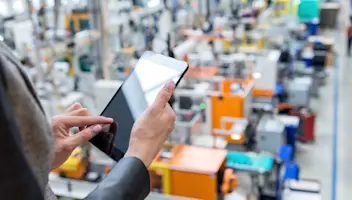4 Important Manufacturing Lessons from 2021
4 Important Manufacturing Lessons from 2021
4 Important Manufacturing Lessons from 2021
21 Dic 2021
Andy Pickard
It’s been a broadly positive, if unpredictable, year for the manufacturing sector. After a difficult 2020, output has increased in 2021, with 65% of manufacturers returning to a position of recovery or prosperity, according to new Aptean research.
But even though output is improving, there are still lessons to be learned and ways to improve. As we say goodbye to 2021, it makes sense to look back at how the manufacturing industry has changed, and what key takeaways we can take forward into the next 12 months.
Lesson 1: The JIT Manufacturing Model Is Vulnerable to Supply Chain Disruption
Undoubtedly, supply chain disruption has been one of manufacturing’s toughest challenges in 2021, and issues continue to impact productivity. Recent research by Aptean revealed that 88% of manufacturers are still experiencing longer-than-usual supplier lead times, as rising costs, high demand and transportation shortages impact the global flow of raw materials.
As we discussed in our whitepaper on increasing manufacturing supply chain resilience earlier this year, just in time (JIT) manufacturing has been a highly successful commercial model, but it leaves manufacturers vulnerable when there are material delays. And events like the pandemic and the global microchip shortage have demonstrated the risks associated with organizations being over-reliant on a limited number of suppliers.
How will things change in 2022?
To improve supply chain performance and avoid a repeat of this year’s setbacks, we’re going to see manufacturers widening their supply networks. In addition to working with a larger number of suppliers, we’re likely to see an increase in onshore sourcing, to provide a ‘plan B’ if affordable international supply capabilities become constrained.
We’re also going to see greater investment in manufacturing supply chain technology. Manufacturers will be striving for greater data visibility and process automation/agility to help them react to supply network changes quicker.
Lesson 2: Manufacturing Employees Expect a Tech-First Approach
While manufacturing output grew to a 2.5 year high in 2021, industry progress was curtailed by chronic labor shortages. Over 3.5 million manufacturing jobs will need to be filled over the next decade, but organizations are currently struggling to fill vacant positions.
It’s not just headcount that’s posing a problem, either. The skillsets that manufacturers require to thrive in a post-pandemic, increasingly digital environment are changing; we’ll talk more about this in a moment.
A major generational shift is taking place in the manufacturing industry, and this is shaping not only available talent, but workplace expectations.
As the most experienced, knowledgeable professionals retire they are being replaced by a young, digital native workforce. Generation Z are not only bringing new skills to the shop floor; they are bringing a tech-first approach to life, and many find a stark contrast between their connected personal lives and the outdated processes and systems they encounter in the manufacturing plant.
How will things change in 2022?
Manufacturers will be taking a fresh look at what ‘people power’ is required to run an efficient operation, and where technology can both take over previously manual tasks and support the value of employees—particularly on the shop floor. We’ll see more organizations automating repetitive everyday processes that need to be completed accurately and efficiently but require little skill. This will allow the workforce to focus on more complex, strategic and innovative tasks.
While automation will inevitably result in some workforce streamlining, it will also cement the roles of manufacturing workers by focusing on adding value. And by taking laborious admin tasks off their shoulders and giving them the data insights and digital tools to make quick, effective decisions, employees will feel more satisfied, motivated and loyal to the manufacturing industry.
Lesson 3: Digital Transformation Is an Immediate Priority
Manufacturers have long recognized the role of technology in improving performance, but the events of the past 12-18 months have shifted smart factory transformation form a medium-term objective to an immediate priority.
In 2021, digital investment focused on solutions to support working from home (6 in 10 manufacturers have put technology in place to help staff access data and systems remotely), but the scope for change will widen over the next 12 months as organizations look to provide employees with more sophisticated operational data.
Manufacturing organizations have seen first-hand the competitive benefits of integrating data, processes and operations, and how much quicker industry leaders who’ve already completed digital transformation projects have recovered from market disruption. As a result, they will start making broader investments and increasing automation in 2022.
How will things change in 2022?
Manufacturers will be looking for holistic technologies like manufacturing ERP software that connect every part of their business and optimize operations end-to-end. And those that invest in cloud-based solutions will be best-placed to evolve and scale quickly.
For manufacturers with a smart factory infrastructure already in place, objectives will move beyond optimization to predictive modelling, using artificial intelligence and machine learning to turn the vast volume of data being generated by their business into a cycle of continuous improvement.
Lesson 4: Manufacturers Have a Renewed Responsibility to Operate Sustainably
Retail and consumer goods brands are feeling the pressure of consumer demand for eco-conscious products, with 78% of people more likely to buy an item labelled environmentally-friendly. For manufacturers, this added new considerations to sourcing, production and distribution models, as they take on responsibility for lowering their carbon footprint.
Manufacturers have also discovered the complexities of factoring sustainability into their operational decision-making processes. For example, over-ordering on inventory might make it easier to meet fluctuating customer demand, but it also increases the likelihood of wastage, especially if their inventory includes perishable ingredients.
With brands relying on manufacturers to ‘do their bit’ in building the circular economy, every aspect of manufacturing new needs to be managed wisely to optimize material consumption, reduce avoidable errors and prevent waste.
How will things change in 2022?
Sustainability will influence the way manufacturers work, from introducing paperless operations to remote collaboration, improving equipment maintenance to reducing the overconsumption of energy. Every strategic decision and manufacturing software investment should be geared around finding the fastest, most efficient way of working – not just for manufacturers’ profit margins, but for the environment.
Enjoyed this article? Download Aptean’s 2022 Manufacturing Forecast for more insights into industry trends and changes over the next 12 months.
Related Blogs


¿Todo listo para transformar tu negocio?
Tenemos las soluciones ERP especializadas que necesitas para superar los desafíos de tu sector.






